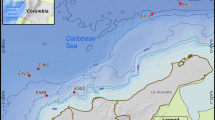Abstract
We obtained 100 isolates of bacteria from deep-sea mud samples collected at various depths (1050–10 897 m). Various types of bacteria such as alkaliphiles, thermophiles, psychrophiles, and halophiles were recovered on agar plates at a frequency of 0.8 × 102 to 2.3 × 104/g of dry sea mud. No acidophiles were recovered. These extremophilic bacteria were widely distributed, being detected at each deep-sea site, and the frequency of isolation of such extremophiles from the deep-sea mud was not directly influenced by the depth of the sampling sites. Phylogenetic analysis of deep-sea isolates based on 16S rDNA sequences revealed that a wide range of taxa were represented in the deep-sea environments. Growth patterns under high hydrostatic pressure were determined for the deep-sea isolates obtained in this study. No extremophilic strains isolated in this study showed growth at 60 MPa, although a few of the other isolates grew slightly at this hydrostatic pressure.
Similar content being viewed by others
Author information
Authors and Affiliations
Additional information
Received: August 3, 1998 / Accepted: October 20, 1998
Rights and permissions
About this article
Cite this article
Takami, H., Kobata, K., Nagahama, T. et al. Biodiversity in deep-sea sites located near the south part of Japan. Extremophiles 3, 97–102 (1999). https://doi.org/10.1007/s007920050104
Issue Date:
DOI: https://doi.org/10.1007/s007920050104




